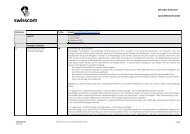Shareholders' Letter
Shareholders' Letter
Shareholders' Letter
Create successful ePaper yourself
Turn your PDF publications into a flip-book with our unique Google optimized e-Paper software.
Available-for-sale financial assets<br />
All other financial assets are classified as available-for-sale financial assets. Available-for-sale<br />
financial assets are accounted for at fair value and all unrealised changes in fair value are recorded<br />
in equity. Foreign exchange gains and losses on available-for-sale debt instruments are recognised<br />
in the income statement. When available-for-sale financial assets are sold, impaired or otherwise<br />
disposed of, the cumulative gains and losses that had been recognised in equity are reclassified<br />
from equity and recorded as financial income or expense. If the fair value of an unlisted equity<br />
instrument cannot be reliably determined, the instruments are accounted for at cost less provisions<br />
for impairment.<br />
3.6 Inventories<br />
Inventories are valued at the lower of purchase or production cost and net realisable value. The<br />
purchase or production cost of inventories includes all costs of acquisition and manufacture as<br />
well as other costs incurred in order to bring the inventories to their present location and condition<br />
as intended by management. The purchase or production cost of inventories is determined by<br />
using the weighted average cost formula. Write-downs are raised for inventories that are difficult<br />
to sell. Unsalable inventories are fully written off.<br />
3.7 Property, plant and equipment<br />
Property, plant and equipment is recorded at cost less accumulated depreciation and amortisation.<br />
In addition to the purchase cost and the costs directly attributable to bringing the asset to the<br />
location and condition necessary for it to be capable of operating in the manner intended by management,<br />
purchase or manufacturing cost also includes the estimated costs for dismantling and<br />
restoration of the site. The manufacturing costs of self-constructed assets include directly attributable<br />
costs as well as indirect costs of material, manufacture and administration. Borrowing costs<br />
are capitalised insofar as they can be allocated directly to the acquisition or production of a qualifying<br />
asset. Costs of replacement, renewal or renovation of property, plant and equipment are<br />
capitalised as replacement investments if a future inflow of economic benefits is probable and<br />
the purchase or manufacturing costs can be measured reliably. The carrying amount of the parts<br />
replaced is de-recognised. Maintenance costs and repairs which are not capable of being capitalised<br />
are expensed. Depreciation and amortisation is calculated using the straight-line method<br />
with the exception of land, which is not depreciated.<br />
The estimated useful lives for the main categories of property, plant and equipment are:<br />
Category Years<br />
Buildings and leasehold improvements 10 to 40<br />
Cables 1 20 to 30<br />
Ducts 1 40<br />
Transmission and switching equipment 1 4 to 15<br />
Other technical installations 3 to 15<br />
Other installations 3 to 15<br />
1 Technical installations<br />
When significant parts of an item of property, plant and equipment comprise individual components<br />
with differing useful lives, each component is depreciated or amortised separately. The estimated<br />
useful lives and residual values are reviewed at least annually as of the balance sheet date<br />
and, if necessary, adjusted. Leasehold improvements and installations in leased premises are amortised<br />
on a straight-line basis over the shorter of their estimated useful lives and the remaining<br />
minimum lease term. The carrying amount of an item of property, plant and equipment is written<br />
off on disposal or whenever no future economic benefits are expected from its use. Gains and<br />
losses arising on the disposal of property, plant and equipment are calculated as the difference<br />
between the disposal proceeds and the carrying amount of the item of property, plant and equipment.<br />
They are taken to income and recorded as other income or other operating expenses.



